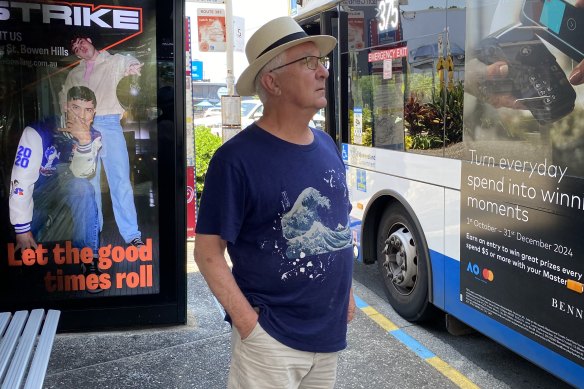- Exclusive
- National
- Queensland
- City life
The Brisbane streets where parking meters are busy and spots are rare
For 30 years, Malcolm Middleton had a car park in the city, so he drove to work. Now, he wouldn’t dream of parking in town.
Middleton, who spent 10 years as the Queensland Government Architect, is one of thousands of people hopping onto public transport, but our exclusive analysis reveals demand for inner-city street parking continues to challenge supply.
Using Brisbane City Council data, Brisbane Times can reveal the hardest areas to find a metered parking spot are in South Brisbane, Spring Hill, the CBD, Woolloongabba, West End, Newstead and Bowen Hills.

Queensland Walks board member Malcolm Middleton used to drive to work in the city, but now happily catches the bus.
During the week, the three-hour parking spots on the mostly residential Birley Street in Spring Hill – near Brisbane Private Hospital – are often all gone by 9am.
Graham Street in South Brisbane, near the Queensland Children’s Hospital and Somerville House, where cars can stay for 12 hours, is also busy, particularly on Thursday afternoons.
In West End, Anthony, Bank, Boundary and Vulture streets are often full of parked cars, while demand is high in Cordelia Street and Stephens Road in South Brisbane.
On weekends, drivers are lucky to find parking on Grey Street at South Bank, with its meter occupancy the highest in the inner-suburbs, on average, almost every hour between 7am and 6pm on Saturdays and Sundays.
Ann Street, between Queen and Wharf streets, is a hotspot on Saturday and Sunday nights from 7pm, when it stops being a clearway.
Montpelier Road in Bowen Hills; Lotus Street in Woolloongabba; Creswell and Kyabra streets in Newstead; and Blamey Street in Kelvin Grove are other tricky spots for parking.
Although these inner-city locations are covered by good public transport, Middleton – now a board member with Queensland Walks – says people are culturally accustomed to driving in Brisbane.
“So there’s an expectation that comes with that – that you’ll be able to park right outside wherever it is that you want to go,” he said.
“And as the place gets more dense, you can’t do that, and it’s not a reasonable expectation.”
Middleton said while he didn’t mind catching the bus in the morning, he drove in for the three decades he worked in the city because he often did something after work and the “car was very convenient to go home”.
But three years ago, Middleton switched to the bus.
“I never think about parking in the city: one, it’s too expensive, and two, I don’t need to – it’s actually easier to catch the bus,” he said.
“The transformation in my attitude was brought about by actually doing it.”
The launch of 50¢ fares is one factor shifting attitudes and boosting patronage: a family of four might find the lure of cheaper travel to South Bank an incentive to ditch driving and parking, even if public transport is less convenient, especially for residents in outer suburbs.
Middleton said South Brisbane was high density, quite walkable and relatively flat.
“Prioritising walking, or these localised free loop bus services, I think is something we really should be doing, and not looking to be expecting to find a car park on the street,” he said.
Transport chair Cr Ryan Murphy said council was building better roads and delivering new and improved public transport options, plus new traffic light technology.
“We will always offer on-street and off-street car parking for those who need to drive, with our on-street parking systems, residential parking permits, and significant investments in public and active transport providing a range of travel options,” he said.
Brisbane Times analysed more than 500 parking meter zones over two years, generating the highest occupancy figure, on average, for each hour and day of the week.
Council uses parking occupancy survey data, meter transactions, traffic and environmental data, advanced analytics and machine learning to estimate paid parking availability, including forecasting.
Start the day with a summary of the most important and interesting stories, analysis and insights. Sign up for our Morning Edition newsletter.